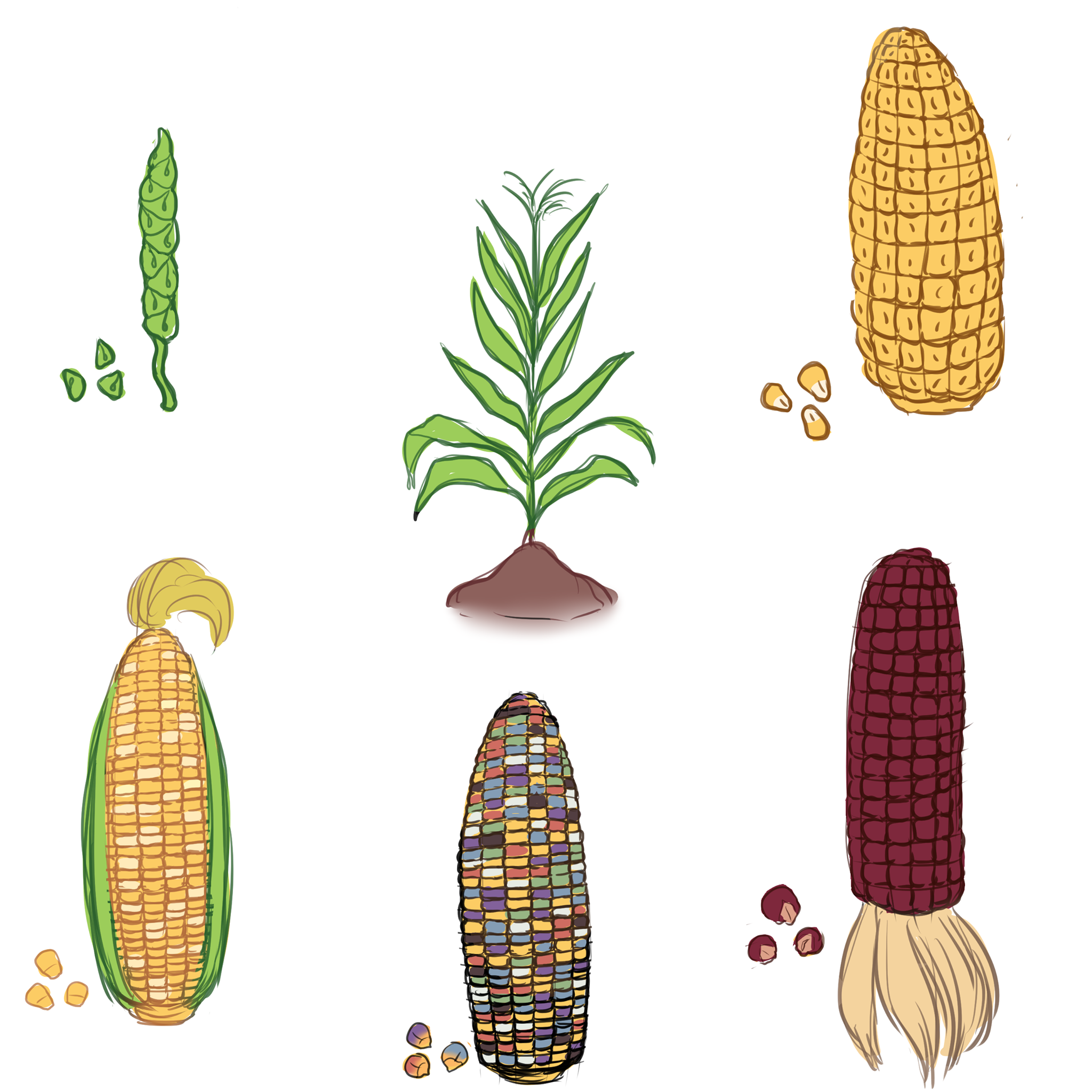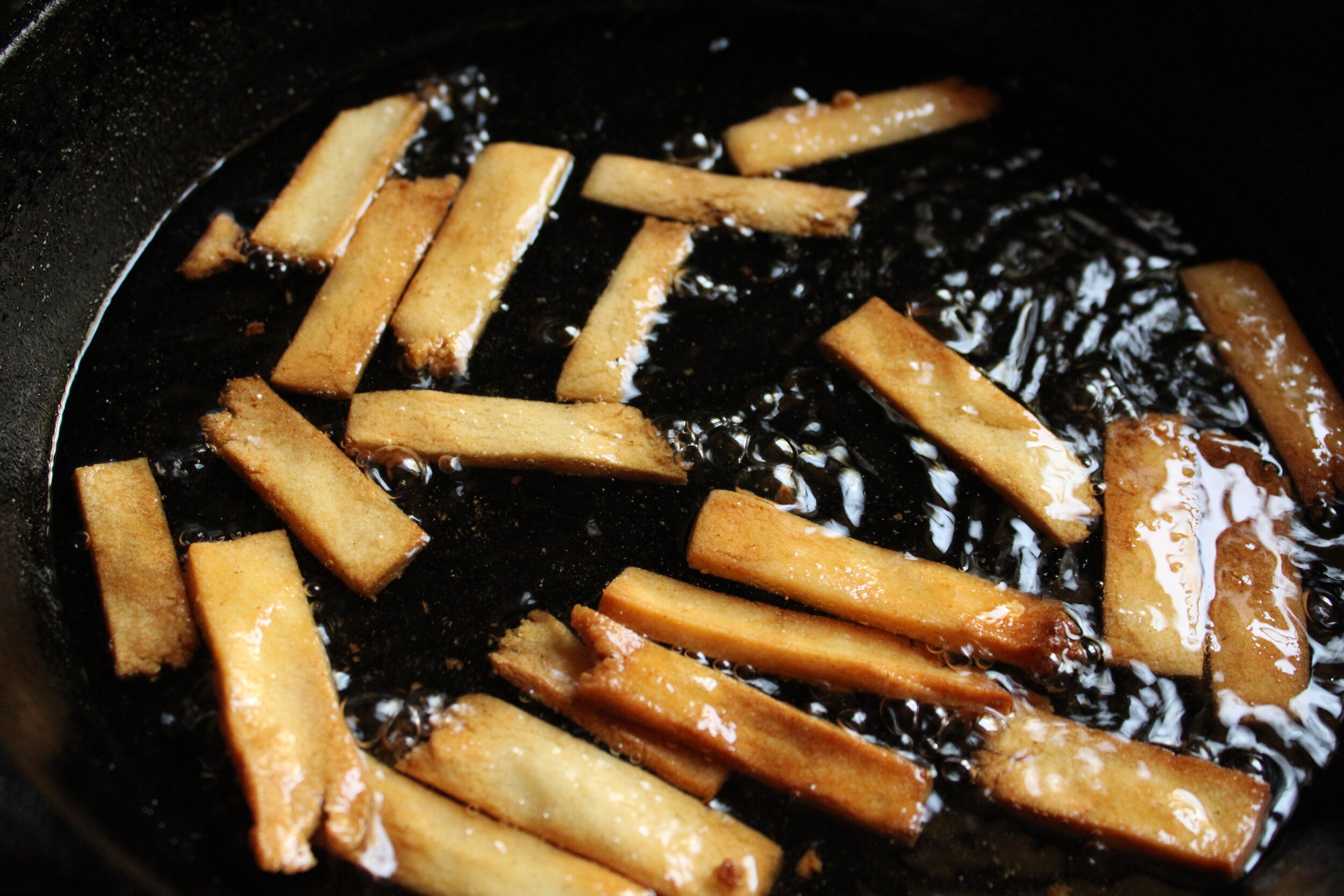Corn Origins

Tlaolli (Nahuatl, Aztec language) - Mahis (Taino/Arawak language) - Maíz (Spanish) - Zea mays (Latin) - Maize (English) - Corn (U.S. American)
The corn we know today is a grass in the poaceae plant family, and is believed to have originated from the teosinte plant in Mexico over 6,000 years ago.
Teosinte grew tall and produced mostly leaves with very tiny heads of corn kernels. Indigenous Mayan, Aztec, and Incan people from South and Central America cultivated teosinte over the centuries to produce larger heads of corn which over time came to look like the large kerneled heads we think of when corn comes to mind.
Additionally, prior to the colonization of the Americas and Caribbean, corn wasn’t seen as just a food but played an important role in the lives of Indigenous people. For example the Choctaw and Chickasaw people had a calendar with 13 months, celebrated at each new moon, starting in March, and two of those new moon celebrations were dedicated to corn.
The third moon (May) was for She-Corn and the seventh moon (September) was for great corn. In addition to being recognized in two months, corn was also a part of an important Indigenous agricultural practice that is still used today. This practice has corn sown on an earth mound, then beans and squash are sown close to it. Together these plants grow alongside each other to provide structural support as well as nutrients and shade for the soil.
Throughout various parts of the Americas Indigenous groups (Iroquois, Natchez, Choctaw, Chickasaw, and many others) call this method “the three sisters”. In the Caribbean islands, Taino people called this agricultural technology “conucos”, in which they might grow plants like cassava with banana trees together. These Indigenous agricultural technologies today might be used or adapted under white monikers like “permaculture methods”, “companion planting”, “inter-cropping”, “intensive growing methods”, or “lean farming”.
Like many plants, corn has many names, and it was changed from the original names Indigenous people of the Americas and Caribbean had given it (e.g. mahis, tlaolli, and many more) to English and Spanish names (maíz, maize, and corn) due to colonization. When Spanish colonizers, such as Christopher Columbus, arrived in the Dominican Republic in the 1400s they learned that the Indigenous Taino people called corn mahis, which the Spanish changed to maíz. Maize would come to be called corn in the United States, originating from the German, Dutch, and Old English words for “an important grain”.
CORN’S MIGRATION TO OTHER LANDS
From the Dominican Republic, Spanish colonizers brought corn back to Europe and from there it would make its way to West Africa in the 1500s with Portuguese colonizers. Countries in this region, such as Nigeria, were already growing indigenous grains like millet and sorghum to make staples like bread, dumplings, and porridge. Therefore when corn was introduced they swapped it in to make those same staples. By the time the trans-atlantic slave trade had gone full swing in the 1600s corn had become very much apart of West African diets, as it was an abundant and reliable grain to grow and store.
Slave traders would eventually take note of West Africans’ dietary preference for corn, and would stock cornmeal on slave ships to feed captured people during their journey to new colonies on North American and Caribbean coasts. Once in the colonies, enslaved West Africans would continue to encounter corn as part of their food rations from enslavers along with pork fatback.
On top of that since the Indigenous people of the Americas had already been growing and using corn for centuries they would over time share new or similar methods of preparing corn with West Africans. One of these similarities was using leaves to wrap and cook corn, or placing them on hot ashes. These exchanges would facilitate corn becoming a foundational ingredient in the Black foodways of the Americas, Caribbean, and African continent that is still important today.
Corn Receipts Around the Site
Dig Deeper . . .
Soul Food (Chapter 11 pg. 186-207) by Adrian Miller
Maize as A Staple Food by Elizabeth Ortiz https://books.google.com/books?id=I15eJt6U3gMC&pg=PA134&lpg=PA134&dq=Ortiz+Maize+as+a+staple+food&source=bl&ots=W93zdQ6Av4&sig=ACfU3U2ZIrh2_JrR9cbM1OW9ufE0TXrjTg&hl=en&sa=X&ved=2ahUKEwjclruo7u_mAhVxmuAKHUk9DOYQ6AEwAXoECAwQAQ#v=onepage&q=Ortiz%20Maize%20as%20a%20staple%20food&f=false
Dethroning the Deceitful Pork Chop Book: Rethinking African American Foodways from Slavery to Obama Book (Chapter 2: Native American Contributions to African American Foodways: Slavery, Colonialism, and Cuisine) Chapter by ROBERT A. GILMER Book Editor, JENNIFER JENSEN WALLACH Published by: University of Arkansas Press. (2015) Stable URL: https://www.jstor.org/stable/j.ctt1ffjdh9.8 https://www-jstor-org.proxy.wexler.hunter.cuny.edu/stable/pdf/j.ctt1ffjdh9.8.pdf?ab_segments=0%2Fbasic_SYC-4802%2Ftest2&refreqid=search%3A2c3fd6b5fcb02ce149099ba3e8d57725
A Corn-Fed Nation: Race Diet and the Eugenics of Nutrition by Helen Zoe Viet https://www.jstor.org/stable/pdf/10.5149/9781469607719_veit.9.pdf?ab_segments=0%2Fbasic_SYC-5055%2Fcontrol&refreqid=search%3A8531e0d6ccd420feb6bbe2b28f9cb54c


